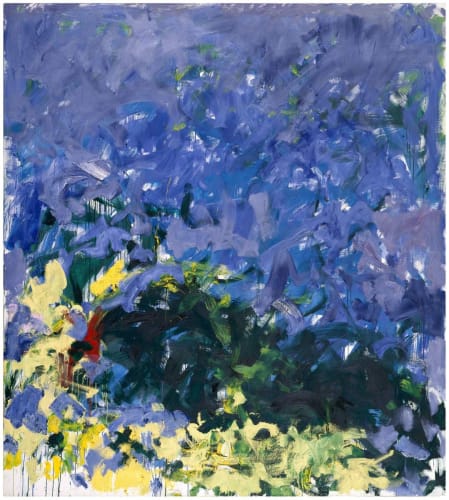Joan Mitchell 1925-1992
Joan Mitchell was a leading American Abstract Expressionist painter and printmaker. Working in an inventive gestural style, Mitchell’s works are characterized by their luminous layers of color and inspiration from nature. “My paintings are titled after they are finished. I paint from remembered landscapes that I carry with me and remembered feelings of them, which of course become transformed,” she once reflected.
Born on February 12, 1925 in Chicago, IL, Mitchell earned both her BFA and MFA from the School of the Art Institute of Chicago. Moving to New York in the late 1940s, she was introduced to the ideas espoused by artists like Willem de Kooning, Jackson Pollock, and Hans Hofmann. In 1951, Mitchell was included in the groundbreaking “Ninth Street Show,” curated by Leo Castelli at the Artists’ Club in Greenwich Village.
Over the following decades, the artist divided her time between Paris and New York, developing the style of blocky shapes of lyrical color for which she is now known. Mitchell died on October 30, 1992 in Paris, France at the age of 67. Her works are featured in the collections of the Centre Georges Pompidou in Paris, The Museum of Modern Art in New York, and the Tate Gallery in London, among many others.
Joan Mitchell attended the School of the Art Institute of Chicago. Upon graduating in 1947, she was awarded a travel fellowship that took her to France for a year, where her paintings became increasingly abstract. Returning to the United States in 1949, Mitchell settled in New York and became an active participant in the “New York School” of painters and poets. She exhibited in the famous “9th Street Show” in 1951, and soon established a reputation as one of the leading young Abstract Expressionist painters. In 1955, Mitchell began dividing her time between New York and France, and in 1959 she settled permanently in France, living and working in Paris. In 1968, she moved to Vétheuil, a small town northwest of Paris, where she worked continuously until her death in 1992.
Over her long and prolific career, the defining elements of Mitchell’s world—water, trees, dogs, poetry, music—created images and memories from which she worked. She once said, "I paint from remembered landscapes that I carry with me—and remembered feelings of them, which of course become transformed. I could certainly never mirror nature. I would like more to paint what it leaves me with." She observed her landscape intensely, and her acute visual observations of form, space, and color in life were part of the visual memories she drew upon while painting.
Mitchell achieved significant critical and commercial success in her lifetime, exhibiting regularly in New York and Paris throughout the later decades of her life. The Whitney Museum of American Art, the Art Institute of Chicago, The Museum of Modern Art, and other major institutions began collecting her paintings in the 1950s. Her work was the subject of a mid-career retrospective exhibition at the Whitney Museum in 1974. In 1982, Mitchell became the first female American artist to have a solo exhibition at the Musee d'art moderne de la Ville de Paris. A retrospective exhibition, The Paintings of Joan Mitchell: Thirty-six Years of Natural Expressionism, toured the United States in 1988, with stops at the Corcoran Gallery of Art, Washington, DC; the San Francisco Museum of Art; the Albright-Knox Art Gallery, Buffalo, New York; the La Jolla Museum of Contemporary Art, La Jolla, California; and the Herbert F. Johnson Museum of Art, Cornell University, Ithaca, New York.
Mitchell’s major awards and accomplishments include: Le Grand Prix des Arts (Peinture) of the City of Paris (1991); the Award for Painting from the French Ministry of Culture (1989); the inaugural Distinguished Artist Award for Lifetime Achievement from the College Art Association of America (1988); Honorary Doctorates from the School of the Art Institute of Chicago (1987) and The Western College, Oxford, Ohio (1971); and the Premio Lissone, Milan (1961).
As an extension of her commitment to sustaining an environment of dedication and camaraderie among artists, Mitchell gave personal support to many young artists and writers who came to stay with her at her home in Vétheuil—sometimes for just one night, sometimes for an entire summer. Correspondence in her papers reveals that this generosity often had a life-changing impact on those who spent time with her.
Mitchell died in Paris on October 30, 1992. Her generosity in her own lifetime continued after her death with the formation of the Joan Mitchell Foundation, called for in her will in order to create support and recognition for individual artists. In addition, the Foundation’s mission includes the promotion and preservation of her legacy, which includes her remarkable body of work, her papers (including correspondence and photographs), and other archival materials related to her life and work.

